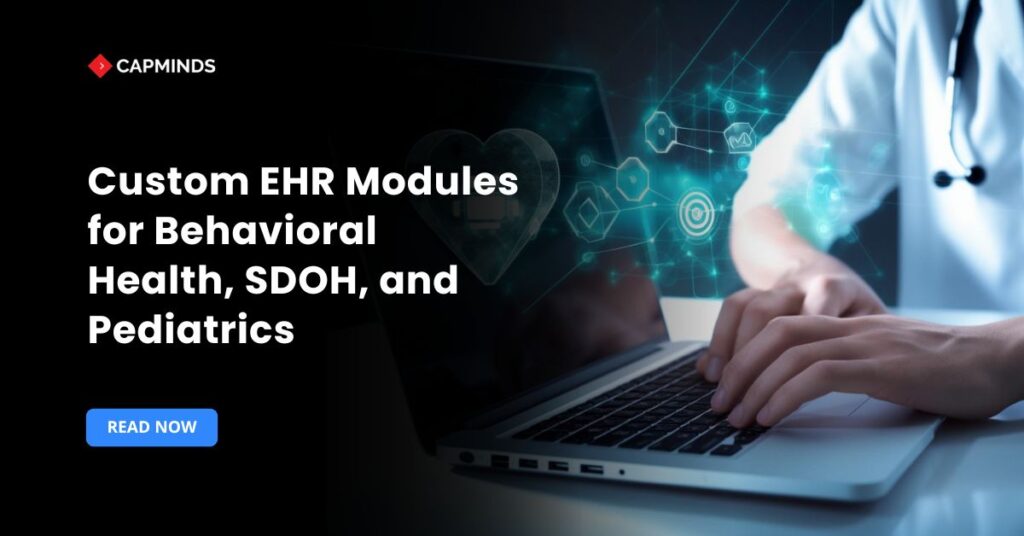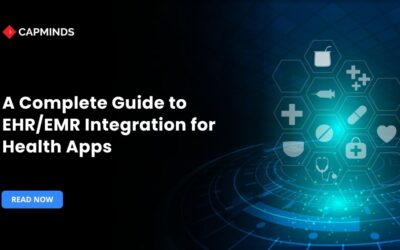Custom EHR Modules for Behavioral Health, SDOH, and Pediatrics
Healthcare isn’t the same for every provider. A behavioral health therapist, a pediatrician, and a social worker addressing housing or nutrition needs all employ different workflows. Yet many still rely on one-size-fits-all EHR systems. Those generic platforms can make things harder. Surveys show most doctors believe their EHR tools require serious upgrades. Almost 70% point to poor integration and data sharing as their main frustrations.
That’s why custom software modules, built for mental health, pediatric care, or social-determinant tracking, are so valuable. Plugged into existing EHRs or EMRs, these modules streamline daily tasks. They capture details that standard systems often miss. And they help providers deliver better, more informed care.
In this blog, we’ll explore how custom EHR modules for behavioral health, SDOH, and pediatrics work. We’ll highlight their key features. And we’ll share real-life examples showing how clinics benefit from using them.
Why Customize? Aligning EHRs with Specialized Care Needs
Most EHR systems are designed for general use. They try to fit every type of healthcare practice into the same mold. But instead of helping, this often forces doctors and specialists to work around the software, not with it. That mismatch causes daily frustration.
Providers end up clicking through unnecessary screens or entering the same data twice. Important details get lost. And over time, all those extra clicks lead to burnout. While a generic EHR might meet the basic need of digitizing records, it rarely serves as a true support system for clinical care.
- Custom-built modules change this entirely. These tools adapt the software to match the way each specialty works. Everything, from templates to workflows, can be fine-tuned to remove clutter and focus on what matters.
- Reports suggest that smart EHR customization and automation can raise clinician efficiency by up to 20%. That means more time with patients and less time spent documenting.
- It also helps reduce errors and missed details. A well-optimized EHR improves workflows, reduces mistakes, and makes it easier for care teams to stay in sync.
Modern modules go even further by using cloud technology and open standards to connect with other systems. A good module uses an interoperable API, often based on HL7 FHIR, to link with labs, pharmacies, public health databases, and even social services.
Health IT experts recommend using secure, HIPAA-compliant platforms that support open APIs. This way, information can move safely and instantly between systems.
And because these tools are cloud-based, doctors can access them from anywhere, whether they’re in the clinic, on a video call, or meeting patients in the community.
Behavioral Health: Streamlining Mental Health Workflows
Therapists and counselors often need to do more than just tick boxes. They write in-depth session notes. They track emotional progress over weeks or months. Many also rely on mental health assessments like the PHQ-9 to better understand how their patients are doing.
At the same time, they need to stay connected. That might mean sharing updates with a patient’s primary doctor or checking in with another specialist. They also have to bill accurately using behavioral health-specific codes, which many general EHR systems don’t fully support.
There’s another layer too: strict privacy rules. Sharing sensitive details without the right consent can lead to serious trouble. But when an EHR doesn’t handle this well, providers often fall back on scattered workarounds, spreadsheets, printed forms, and disconnected apps.
It’s not efficient. And more importantly, it’s not safe.
Key Challenges in Behavioral Health EHR
Mental Health Professionals’ work is personal, in-depth, and constantly evolving. So, they need tools that fit how they actually work. A big part of that involves writing open-ended notes, recording emotional progress, and using screening forms like the PHQ-9 to keep tabs on conditions like depression.
But the job goes beyond the therapy room. Mental health providers often stay in touch with a patient’s primary care physician or loop in another specialist. Getting paid also comes with its challenges, especially when billing systems don’t understand the codes used in behavioral health.
And let’s not forget the rules. Sharing patient information, especially sensitive details, comes with layers of consent and privacy laws. If the EHR doesn’t support this, providers are left juggling too many tools. Some turn to spreadsheets. Others go back to paper.
That patchwork slows them down. Worse, it can lead to missed details or a breach in confidentiality.
How Custom Modules Help to Solve Them
Mental health practices work differently, and they need software that reflects that.
A custom EHR module designed for behavioral health does exactly that. It brings in features built specifically for therapists, counselors, and psychiatrists.
- Take documentation, for instance. Instead of forcing providers to build every note from scratch, these modules offer ready-to-use templates for therapy sessions, evaluations, and follow-ups.
- They’re often filled with phrases and checkboxes that match how mental health work is done. This keeps records consistent and cuts down on typing.
- Many of these systems also come with built-in screening tools.
- A therapist might pull up an anxiety scale or a substance use questionnaire, fill it out with the patient, and see the scores charted instantly.
- Over time, this makes it easy to track changes and spot patterns.
Another key feature? Goal tracking. These EHRs often include simple tools to map out treatment plans, set goals, note progress, and adjust interventions along the way.
For therapy that depends on small steps and steady improvement, that level of structure helps.
Related: Custom EHR/EMR for Behavioral Health: A Complete Roadmap from Development to Implementation
Key Features of a Behavioral Health EHR Module
- Tailored templates and note-taking: Mental health notes aren’t one-size-fits-all. Most EHR systems built for behavioral health come with plug-and-play templates for things like session notes, treatment plans, and risk assessments. You can tweak them to match your team’s flow. That means less typing and fewer missing details.
- Built-in clinical tools: Instead of printing out PHQ-9s or GAD-7s, these forms are baked right into the system. You don’t just get scores, you also get automatic flags if something looks off. Say a patient shows high suicide risk, or there’s a med interaction to consider. The system catches it early.
- Team-based care coordination: Care usually involves more than one person. These platforms make it easier to loop in everyone, social workers, primary care doctors, and psychiatrists. With secure messaging, shared notes, and simple referral tools, no one gets left out of the loop.
- Remote access and telehealth features: Sometimes it’s a virtual session. Other times, it’s a visit to someone’s home or even a crisis call in the middle of the night. With mobile-friendly access and telehealth features built in, providers can stay connected no matter where care happens.
- Strong privacy and compliance safeguards: Mental health records require serious privacy protections. These systems lock things down with HIPAA and 42 CFR Part 2 compliance. That includes detailed access controls and automated consent forms. You’re not stuck worrying if a record was shared by mistake.
- Data-driven insights: Good care isn’t just about what happens in the room. It’s about tracking how things change over time. Built-in dashboards help you see symptom trends, treatment goals, and whether patients are moving in the right direction. And if you’re part of a value-based program, these reports make that work visible.
When the right tools are in place, the EHR stops getting in the way and starts doing its job. For mental health professionals, that means more time spent listening and less time wrestling with software.
A well-designed system quietly supports their workflow, allowing them to focus on what matters most: the patient sitting in front of them.
Related: The Top Features a Behavioral Health EHR Must Have
Social Determinants of Health (SDOH): Capturing the Full Patient Story
Treating someone’s illness is only part of the picture. Healthcare teams have started to see that now. You can prescribe all the right meds and schedule every follow-up, but if the person goes home to a cold apartment and an empty fridge, you’re not fixing the root problem.
- Where someone lives, how they get around, whether they have food on the table or people who check in on them, that stuff matters. A lot more than we gave it credit for.
- These are what we call the Social Determinants of Health. And they’re behind the scenes in most outcomes, way more than procedures or pills.
- Think about diabetes. Sure, insulin helps. But if someone’s skipping meals or can’t make it to their appointments because the bus doesn’t run past 6, their blood sugar isn’t going to stay steady.
- That’s the kind of stuff traditional EHRs weren’t built to track.
Most of the time, if we ask those questions, the answers go in a paper form, or worse, someone’s memory. And if it’s not in the system, the next provider might not even know. So we miss things. Not because we don’t care, but because the tools weren’t made for it.
That’s finally starting to change. New EHR features are bringing this kind of context front and center, right in the chart. So when a doctor pulls up a patient’s record, they don’t just see bloodwork. They see the real-life stuff that makes or breaks their care plan.
Challenges Without SDOH Integration
In many clinics, screening for social needs has been an afterthought, if it happens at all. Even when someone does ask the right questions, the answers often get buried in handwritten notes or tucked away in standalone forms. That makes it hard for providers to follow up later. Did the patient who flagged housing issues last month ever get help? No one’s sure.
Without a consistent way to record and flag this kind of information in the EHR, important clues can get missed. A patient who keeps skipping appointments might not be careless; they might just not have a ride. But if that detail isn’t captured in the right place, the care team may never know.
There’s another challenge, too. Referring patients to local support services, like food banks or shelters, is only half the job. Without a connected system, tracking what happened next becomes difficult. Did the patient reach out? Did they get what they needed? Without integration, that feedback loop is often broken.
How Custom SDOH Modules Help to Solve Them
An SDOH-integrated EHR module brings those vital social factors into the care workflow in a structured, actionable way.
- Let’s say a clinic uses a standard tool like PRAPARE or the AHC-HRSN to ask patients about things like housing, food access, or job stability.
- Those questions can be answered by a medical assistant, or even by the patient using a tablet in the waiting room. The answers don’t just disappear into a note; they’re saved in the system as structured data.
This shift alone makes a big difference. Research shows that when clinics use built-in social needs screening, the amount of documented SDOH information can more than triple. That’s data that was either lost in paperwork or never collected at all, and now it’s right there when it matters most.
A provider sits down with a patient managing diabetes. Along with reviewing their labs, the system shows a flag that this person has been struggling to afford groceries. That one detail changes everything. It might lead to a referral for nutrition support or help in enrolling in a local food program.
By surfacing this kind of context during the visit, the EHR becomes more than just a digital file cabinet. It becomes a tool that helps the care team treat the person, not just the condition.
Key Features of an SDOH EHR Module:
- Structured screening for social needs: Clinics can now use built-in questionnaires to gather information on housing, food access, transportation, and more, right inside the EHR. These responses are saved in a clear, structured format using standard medical codes, making it easier to share data across systems when needed.
- Smart alerts and helpful reminders: If a patient shows signs of food insecurity, the system can prompt the provider to recommend a nutrition consult. Or if someone keeps missing appointments, it might trigger a gentle reminder for the care team to ask about transportation. These small nudges help staff catch things that might otherwise go unnoticed.
- Direct social referrals with follow-up: Instead of writing down a phone number or handing out a pamphlet, providers can send a referral to a local food bank or shelter directly through the EHR. What’s more, they can receive updates when the patient gets support, closing the loop so nothing falls through the cracks. For instance, a “Refer to community service” button that connects with local resource networks and logs the referral outcome in the chart.
- Care plan integration: Social needs and goals become part of the patient’s care plan. The module enables care teams to record interventions and follow-ups. This promotes accountability and tracking of social care alongside medical care.
- Population health analytics: Dashboards that aggregate SDOH data to identify trends and measure the impact of interventions on health outcomes or utilization. This helps practices target community partnerships and demonstrate improvements in population health.
- Interoperability and standards compliance: Support for HL7 FHIR SDOH profiles to exchange SDOH data with other systems. Compliance with privacy regulations for sensitive information.
By integrating social determinant data into everyday practice, providers can treat the whole patient. As one expert put it, “integrating social care into the EHR is essential,” so clinicians feel equipped to address those needs and support patients beyond the clinic walls.
Custom SDOH modules make that possible, bridging the gap between healthcare and social care for better outcomes and healthier communities.
Pediatrics: Tailoring EHRs for Our Youngest Patients
Children require specialized care, making pediatric EHR modules essential. Pediatricians need growth tracking, immunization automation, development screenings, and weight-based clinical decision support.
However, more than 80% of pediatricians report using EHR systems that lack optimal pediatric functionality, leading to errors in clinical decisions and even medication miscalculations.
Both industry and regulators have called for pediatric-specific EHR improvements. The Agency for Healthcare Research and Quality (AHRQ), for instance, helped develop a Children’s EHR Format outlining critical pediatric functionalities.
Custom pediatric modules incorporate these specialized features to ensure that caring for kids is safer, more efficient, and aligned with pediatric practice workflows.
Unique Challenges in Pediatric EHR Use
Pediatric practices must manage immunization schedules, track growth percentiles at every visit, adjust medication doses by weight or age, and handle family dynamics (like linking siblings and guardians in records).
Documentation for well-child visits often includes developmental milestones, school and sports physical forms, and anticipatory guidance, all of which are different from adult care documentation.
- Without customization, pediatricians may end up manually creating growth charts or constantly calculating drug doses by hand, which is time-consuming and error-prone.
- Another challenge is child-specific privacy and consent: as children age into adolescence, there are often confidentiality considerations.
- A generic EHR might not gracefully handle those nuances, whereas a pediatric-focused module would include appropriate privacy settings per AAP guidelines.
How Custom Pediatric Modules Help to Solve Them
A custom pediatric EHR module equips the practice with tools designed around pediatric workflows. One fundamental feature is an integrated immunization management system. The software maintains an up-to-date immunization registry for each child, tracks which vaccines are due (following CDC schedules), and can alert providers and parents about upcoming or missed shots.
This dramatically reduces the risk of a child missing a critical vaccine, and many systems can produce the needed vaccination compliance forms for school or daycare automatically. Some modules even connect with state immunization information systems to upload records directly, saving staff time.
Key features of a Pediatric EHR module
- Immunization tracking & reminders: Automated vaccine schedules with reminder alerts for due immunizations. Ability to print or electronically share vaccination records and integrate with state registries.
- Growth charts & pediatric decision support: Visual growth and development charts updated at each visit. Built-in calculators for weight-based dosing and age-specific normal vital signs. Alerts for abnormal growth patterns or lab values based on pediatric norms.
- Family linkage and scheduling: Family profile that links patient records of siblings and guardians, enabling one-click access to family history and combined scheduling. Avoids redundant data entry.
- Pediatric-specific templates: Visit note templates for newborn care, well-child visits, school physicals, and more. Custom forms for different age ranges (infant, toddler, adolescent), including developmental and behavioral screenings.
- Parent/guardian portal: Secure online access for parents to view their child’s health data, growth charts, and educational materials, and to communicate with providers. Controls to allow adolescent privacy when appropriate.
- Integrated reporting and referrals: Tools for mandatory reporting (like suspected abuse) are built into the workflow with confidentiality. Referral management to coordinate with pediatric sub-specialists or early intervention programs, ensuring follow-ups don’t get lost.
- Security and compliance: Enhanced data security for pediatric info, including compliance with pediatric data regulations and immunization reporting. Many pediatric EHRs emphasize two-factor authentication and strict user role controls, given the sensitivity of minors’ health data.
Technical Foundations: Cloud, APIs, and Compliance
Building and integrating custom modules is as much a technological endeavor as a clinical one. Modern healthcare software development emphasizes flexibility, connectivity, and security, and custom EHR modules are no exception.
Here are some of the key technical considerations and best practices when implementing these solutions:
Cloud-Based Architecture
Most custom EHR modules today are delivered via cloud-based platforms or Software as a Service (SaaS). A cloud-based module means providers can access the system with just a web browser, with data securely stored and backed up off-site. This offers advantages in scalability, maintenance, and accessibility.
Cloud EHR environments also support easier integration of new modules because standardized web APIs can be used without worrying about on-premise server customizations.
Importantly, reputable cloud EHR providers adhere to strict security certifications and compliance to ensure data safety. When evaluating a custom module, healthcare organizations should ensure the solution uses robust encryption, authentication, and audit controls to meet HIPAA and other regulations.
Interoperability & FHIR Compliance
A custom module must play well with others. Whether it’s pulling patient demographics from the main hospital system or sending a referral to a community service, interoperability is key. Open standards like HL7 FHIR allow modules to exchange specific pieces of data in a standardized format.
- For example, a behavioral health module can use FHIR to retrieve a patient’s allergy list from the primary EHR, or a SDOH module can post a coded observation into the patient’s record that other systems recognize.
- By using RESTful APIs and FHIR resources, custom modules avoid being siloed add-ons; instead, they become an integrated part of the health IT ecosystem.
Many EHRs now offer API marketplaces or SMART on FHIR support, where third-party custom apps can be launched within the EHR interface.
This is an ideal way to implement a custom module; it runs as an embedded app that clinicians see in their normal workflow, but it’s powered by specialized functionality in the background.
Always verify that custom solutions support HL7 standards and can consume/share data with other systems. Interoperability not only streamlines workflow but is increasingly mandated as part of government EHR certification and information blocking rules.
Configurability and User-Centric Design
A hallmark of effective custom modules is the ability to configure to the practice’s exact needs without extensive coding. Look for systems that allow administrators to customize templates, data fields, and user roles easily.
- For instance, a pediatric module should let you add a custom template for a new developmental screening form mandated by your state, or a behavioral health module might allow custom risk scoring rules to be adjusted by the clinic.
- This configurability extends to dashboards and reports. Users should be able to personalize what they see first.
By giving end-users some control, the module can better align with real-world workflows. Additionally, the design should be intuitive and mobile-responsive.
As noted earlier, mobility is crucial for many use cases, so the interface must work well on tablets and phones without losing functionality. An intuitive, user-friendly module also reduces training burden and encourages faster adoption by staff.
Compliance and Security
Healthcare data is highly sensitive, and each domain may have extra layers of compliance. Ensure any custom module is developed following security best practices: end-to-end encryption, strong user authentication, role-based access control, and regular security audits.
- For behavioral health, confirm the module can segregate records per 42 CFR Part 2 if needed.
- For pediatric modules, confirm compliance with consent laws for minors. If the module is cloud-based, inquire about the hosting environment’s certifications.
Also, if the module will handle data exchange, it should comply with the ONC’s certification criteria for EHR modules, which cover things like patient data export, transitions of care, and usability safety enhancements.
Support and Continuous Improvement
Lastly, the technical journey doesn’t end at go-live. High-value custom solutions come with ongoing support, training, and upgrades. Healthcare regulations and practices need to evolve, so your module should too. Partnering with a digital health tech provider often means you get experts who will update the software for new billing codes, new clinical guidelines, or new interoperability requirements.
Ensure that part of the implementation includes training sessions for your team and that the vendor offers accessible customer support. A good development partner will seek user feedback and continue refining the module so that it remains a cutting-edge asset for your practice, not just a static tool.
Specialty-Centric Care With Custom EHR Modules by CapMinds
At CapMinds, we understand that behavioral health, SDOH, and pediatric practices face unique clinical and operational challenges that generic EHRs simply can’t solve.
That’s why we offer end-to-end digital health tech services that go beyond templates, delivering truly customized EHR/EMR modules tailored to your specialty.
Whether you’re a mental health provider, pediatrician, or community care organization, our team helps you streamline workflows, integrate with third-party systems, and elevate patient outcomes.
Here’s how CapMinds supports your transformation:
- Custom EHR/EMR module development for Behavioral Health, SDOH, and Pediatrics
- HL7/FHIR-based interoperability and open API integration
- Cloud-native, mobile-responsive EHR solutions
- Patient engagement portals and telehealth integration
- Compliance with HIPAA, 42 CFR Part 2, and pediatric data privacy standards
Ready to build a smarter, specialty-driven EHR experience? Let CapMinds help you create technology that works the way you do.




